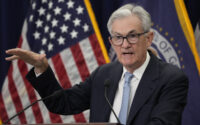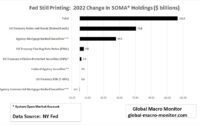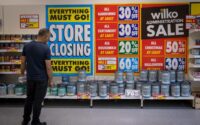Conditions Are Ripe for a Deep Bear Market
With the S&P 500 briefly on Friday down 20% from its January peak, it is very tempting to start trying to call the end of the selloff. The problem is that only one of the conditions for a rally is in place, that everyone’s scared. That worked beautifully for timing the start of the 2020 rebound, but this time around may not be enough.
The other requirements are that investors start to see a way through the challenges, and that policy makers start to help. Without those, the risk is a series of bear-market rallies that don’t last, hurting dip buyers and further damaging investor confidence.
That confidence is already weak. Surveys of sentiment show fund managers (surveyed by Bank of America), private investors (the American Association of Individual Investors) and financial newsletters (Investors Intelligence) are already at March 2020 levels of caution about stocks. Options that protect against market falls haven’t been so popular since back then, either. And consumer sentiment, as measured by the University of Michigan, is actually worse than it was then.
In 2020 that was enough, because central bankers and politicians were frightened, too. When they stepped in it helped investors see that, with government support, companies could make it through.
This time central bankers are scared not by falling markets or the economic outlook, but by inflation. Sure, if something major breaks in the financial system, they will refocus on finance, and a recession may prompt them to rethink rate rises. But for now, inflation means that falling stock prices are seen merely as a side effect of tighter monetary policy, not a reason to invoke the “Fed put” and rescue investors.
There is nothing magical about a fall of 20%, the usual definition of a bear market. But it does crop up a lot: In the past 40 years, the S&P 500 has bottomed out with a 20%-or-so peak-to-trough decline four times, in 1990, 1998, 2011 and 2018. Another four times it had far bigger losses, as true panic took hold.
The common factor in the 20% drops was the Federal Reserve. Each time, the market bottomed out when the central bank eased monetary policy, with the stock market’s fall perhaps helping push the Fed to take the threats more seriously then it otherwise might.
My concern is that this time could be more like 1973-1974. Just as then, the primary concern of the country is inflation, thanks to a war-related oil-price shock. Just as then, the inflationary shock took hold when the Fed had rates far too low given the scale of political stimulus for the economy. Just as then, favored stocks—the Nifty Fifty, now the FANGS and associated acronyms—had soared in prior years.
Most important, in 1974 the Fed kept raising rates even as a recession took hold because it was running to catch up with inflation. The result was a horrible bear market interspersed with soul-destroying temporary rallies, two of 10%, two of 8% and two of 7%, each snuffed out. It took 20 months before the low was reached—not coincidentally, when the Fed finally began to get serious about cutting rates.
So far, this time has been nothing like as bad for stocks, not least because the economy isn’t in recession. If inflation comes down, the Fed won’t need to raise rates as much as it has indicated, which would be a big boon for the stocks that have suffered the most.
I’m still hopeful that the economy will prove resilient, although it will be a long time before we know enough to make it a good bet. In really simple terms, though, after stocks more than doubled in two years, a market fall of more than 20% seems entirely plausible.
SHARE YOUR THOUGHTS
What is your economic outlook right now? Join the conversation below.
Write to James Mackintosh at [email protected]
Copyright ©2022 Dow Jones & Company, Inc. All Rights Reserved. 87990cbe856818d5eddac44c7b1cdeb8
Appeared in the May 23, 2022, print edition as ‘Conditions Are Ripe For Deep Bear Market.’
[ad_2]
Source link


